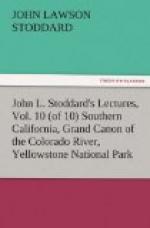Southern California is not only a locality, it is a type. It cannot be defined by merely mentioning parallels of latitude. We think of it and love it as the dreamland of the Spanish Missions, and as a region rescued from aridity, and made a home for the invalid and the winter tourist. Los Angeles is really its metropolis, but San Diego, Pasadena, and Santa Barbara are prosperous and progressive cities whose population increases only less rapidly than their ambition.
[Illustration: An arbor in winter.]
[Illustration: Main street, Los Angeles.]
One of the first things for an eastern visitor to do, on arriving at Los Angeles, is to take the soft sound of g out of the city’s name, and to remember that the Spaniards and Mexicans pronounce e like the English a in fate. This is not absolutely necessary for entrance into good society, but the pronunciation “Angeelees” is tabooed. The first Anglo-Saxon to arrive here was brought by the Mexicans, in 1822, as a prisoner. Soon after, however, Americans appeared in constantly increasing numbers, and, on August 13, 1846, Major Fremont raised at Los Angeles the Stars and Stripes, and the house that he occupied may still be seen. Nevertheless, the importance of Los Angeles is of recent date. In 1885 it was an adobe village, dedicated to the Queen of the Angels; to-day, a city of brick and stone, with more than fifty thousand inhabitants, it calls itself the Queen of the State. Its streets are broad, many of its buildings are massive and imposing, and its fine residences beautiful. It is the capital of Southern California, and the headquarters of its fruit-culture. The plains and valleys surrounding it are one mass of vineyards, orange groves and orchards, and, in 1891, the value of oranges alone exported from this city amounted to one and a quarter millions of dollars. It must be said, however, that there is less verdure here than in well-cared-for eastern towns of corresponding size, and that Los Angeles, and even Pasadena, notwithstanding their many palm trees, have on the whole a bare appearance, compared with a city like New Haven, with its majestic elms and robe of vivid green, which even in autumn seems to dream of summer bloom. Nevertheless, Los Angeles is clean, and poverty and squalor rarely show themselves; while, in the suburbs of the city, even the humblest dwellings are frequently surrounded by palm trees, and made beautiful by flowers.
[Illustration: FREMONT’S headquarters.]
[Illustration: Palatial residences in Los Angeles.]
[Illustration: Los Angeles.]
Another charm of Los Angeles is the sudden contrasts it presents. Thus, a ride of three minutes from his hotel will bring the tourist to the remains of the humble Mexican village which was the forerunner of the present city. There he will find the inevitable Plaza with its little park and fountain, without which no Mexican town is complete. There, too, is the characteristic adobe church, the quaint interior of which presents a curious medley of old weather-beaten statues and modern furniture, and is always pervaded by that smell peculiar to long-inhabited adobe buildings, and which is called by Steele, in his charming “Old California Days,” the national odor of Mexico.




